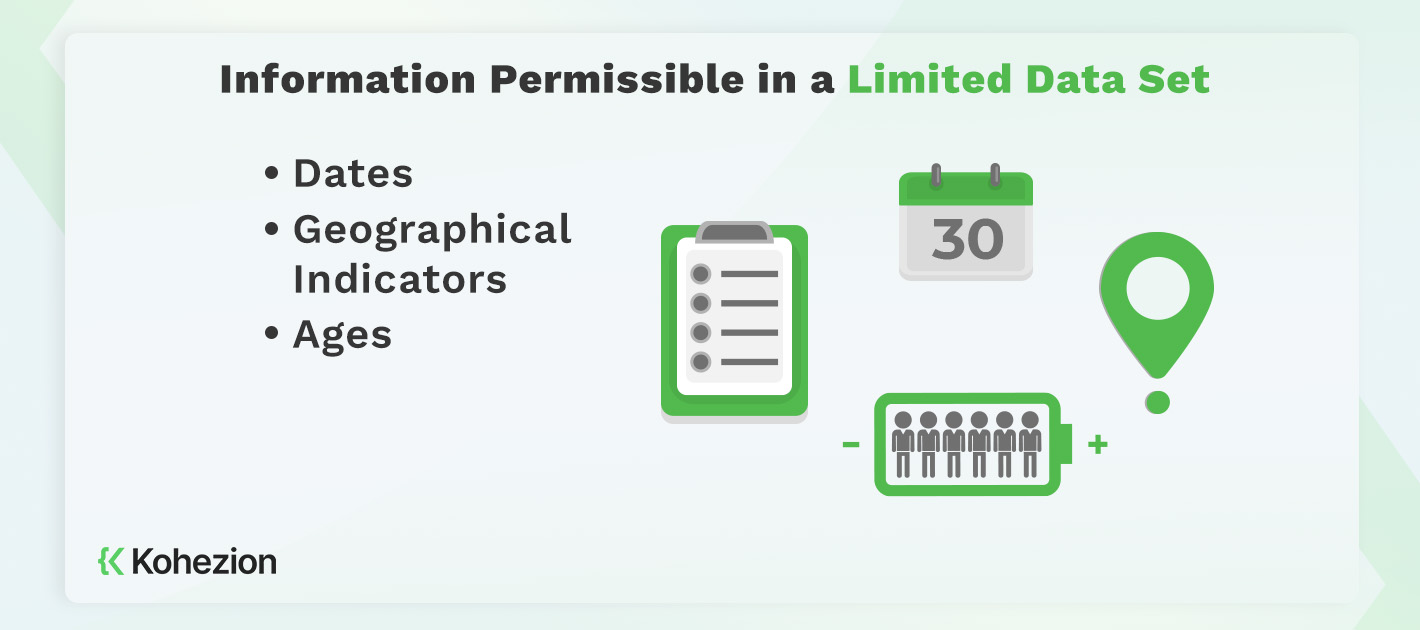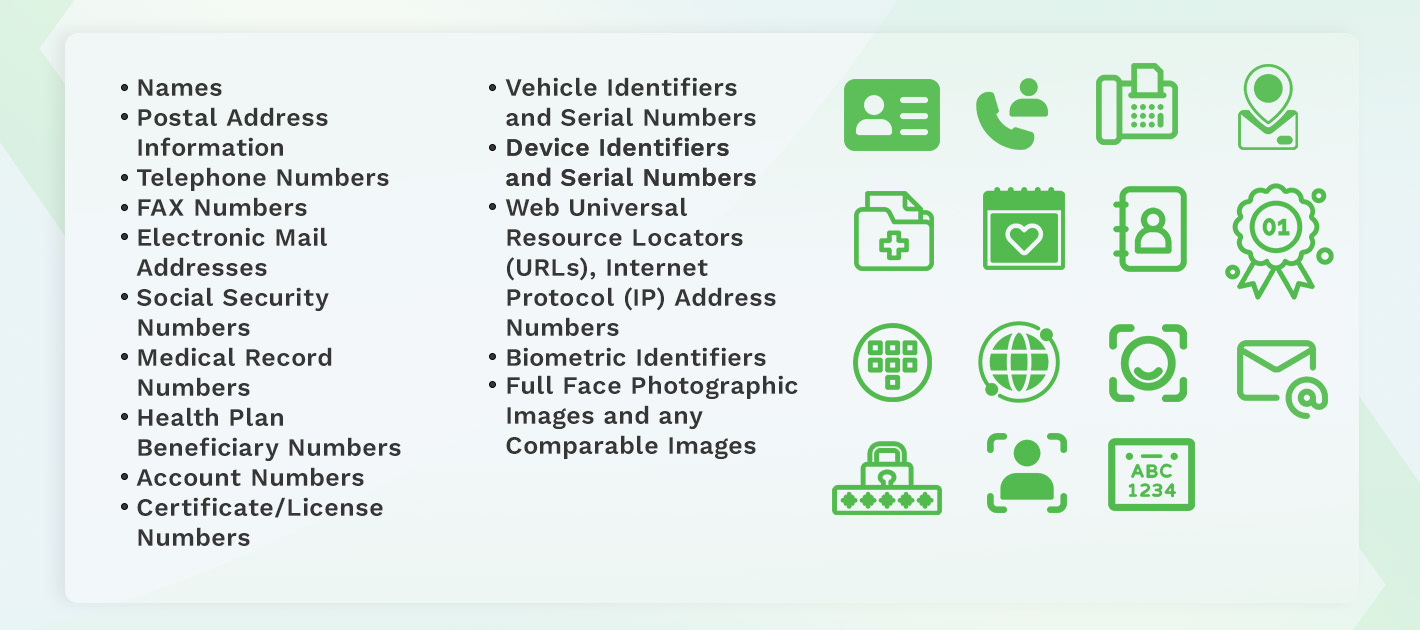HIPAA's notion of a "limited data set" serves as a critical tool, balancing patient privacy with the imperative needs of research and public health operations. This subset of patient information is carefully curated, removing identifiable markers such as names and Social Security numbers, while retaining essential data points valuable for analytics and policy-making. A striking statistic underscores the significance of data protection in healthcare: a report by HIPAA Journal indicated that healthcare data breaches affected over 29 million people in 2020 alone, making the proper handling of “limited data sets” not just a legal compliance issue but a pivotal aspect of maintaining trust in the healthcare system.
We'll buid your first application for you. At no extra cost.
Let us build your first business application for free. Go from an idea to an application in under 2 weeks.

What is a Limited Data Set Under HIPAA?
The Health Insurance Portability and Accountability Act (HIPAA) Privacy Rule is a cornerstone in the safeguarding of personal health information (PHI). Its primary role is to ensure that PHI remains confidential while allowing the proper flow of health information required to provide high-quality health care. The Privacy Rule creates a balance that permits important uses of information while protecting the privacy of people who seek care and healing.
The aim of a limited data set is to allow for the useful sharing of healthcare data for specific purposes, without overstepping the privacy boundaries established by HIPAA. Because the data is stripped of many personal identifiers, it is thought to pose less risk to individuals' privacy.
The Significance of Limited Data Sets in Healthcare
Limited data sets furnish demographic and temporal data and empower epidemiological studies, facilitating trend analysis within specific populations without compromising anonymity. Supporting health services research, they refine policies and strategies through service utilization and outcome data. In clinical trials, researchers leverage limited data sets to identify candidates, monitor adherence, and assess outcomes without breaching privacy. They also aid in public health surveillance, enabling authorities to track disease outbreaks and vaccination rates. Data-driven healthcare organizations bolster delivery quality, safety, and efficiency while respecting privacy through systematic identifier removal and Data Use Agreements, ensuring adaptability amidst evolving research and health challenges.
Key Components of a Limited Data Set under HIPAA
A limited data set for research purposes includes certain identifiable information such as dates, geographic details, and age, without direct identifiers like names and social security numbers, and requires a data use agreement for disclosure as outlined in the HIPAA Privacy Rule.
Information Permissible in a Limited Data Set
Information permissible in a limited data set includes a subset of protected health information from which certain direct identifiers have been removed. Under HIPAA regulations, the following types of data can typically be found in a limited data set:
- Dates: Information regarding an individual's date of birth, date of death, and dates of medical care are allowed.
- Geographical Indicators: City, state, and zip code information can remain, provided it isn't more specific than a five-digit zip code.
- Ages: Patients' ages, including ages over 89 (often categorized as "over 89" to maintain anonymity), and ages expressed in months, days, or hours for individuals under one year of age.
This type of PHI is made available for the purpose of research, public health matters, or healthcare operations where the use of fully identifiable data isn't required. While more anonymous than identifiable health information, limited data sets still contain enough detail to be very useful for certain analyses without compromising an individual’s privacy.
However, all entities handling such information must establish proper safeguards, usually in the form of data use agreements, to ensure they uphold the intended privacy protections.

Exclusions & Required Removals Under HIPAA
HIPAA mandates that the following identifiers of the individual or of relatives, employers, or household members of the individual must be removed from the data to qualify as a limited data set:
- Names: Any form of the individuals’ full names must be completely excluded.
- Postal Address Information: All elements of street addresses are to be stripped away, except for the retention of city, state, and zip code.
- Telephone Numbers: All forms of contact numbers including mobile, home, and work numbers.
- FAX Numbers: Any facsimile numbers that can be directly traced to individuals must be removed.
- Electronic Mail Addresses: Personal and professional email addresses cannot be a part of the dataset.
- Social Security Numbers: This highly sensitive identifier is strictly prohibited in a limited data set.
- Medical Record Numbers: These unique identifiers could lead to the identification of individuals and hence are to be excluded.
- Health Plan Beneficiary Numbers: Similar to social security numbers, these can also directly identify an individual.
- Account Numbers: Any numbers that can be tied to financial or personal accounts.
- Certificate/License Numbers: Professional or governmental licensure numbers must be removed.
- Vehicle Identifiers and Serial Numbers: Including license plates which can be linked to an owner.
- Device Identifiers and Serial Numbers: Such identifiers may reveal the user's identity.
- Web Universal Resource Locators (URLs), Internet Protocol (IP) Address Numbers: For online privacy.
- Biometric Identifiers: This includes fingerprints, retinal scans, voiceprints, and DNA.
- Full Face Photographic Images and any Comparable Images: These can clearly identify an individual and should be removed.
After removing these identifiers, the remaining data can be used within the parameters defined by a data use agreement, aiming to reduce the risk to individual privacy while allowing data to be useful for broader health-related purposes.

Creating and Handling Limited Data Sets
The process for deriving limited data sets from Protected Health Information (PHI) involves meticulous steps to ensure compliance with HIPAA regulations while maintaining data utility for research and healthcare operations.
The Process for Deriving Limited Data Sets from PHI
Deriving limited data sets from protected health information (PHI) involves a systematic process to ensure compliance with HIPAA while retaining data utility for research or healthcare operations. Here’s an overview of the methodology:
- Identification: Identify the PHI that will be transformed into a limited data set and understand the purpose for its use.
- Removal of Direct Identifiers: Rigorously remove all direct identifiers as stipulated by HIPAA. This may require specialized software or manual redaction.
- Review: Conduct a thorough review to ensure that no residual identifiers remain that could be used, alone or in conjunction, to identify an individual.
- Preparation of the Data Use Agreement: Prepare a DUA that aligns with HIPAA’s requirements, defining the permissible uses of the data and the protections that must be in place.
- Approval: Have the DUA reviewed and approved by all requisite parties, including legal counsel, if necessary, to ensure all terms adhere to regulatory standards.
- Secure Transfer: After approval, securely transfer the limited data set to the intended recipient, employing encryption and other security measures as needed.
- Ongoing Monitoring: Continuously monitor the usage of the limited data set to ensure adherence to the stipulations of the DUA and HIPAA, and to prevent unauthorized use.
Legal Framework: Data Use Agreements (DUAs)
Data Use Agreements (DUAs) are vital legal frameworks for governing the use and disclosure of limited data sets under HIPAA standards. These agreements serve as a binding understanding between entities handling the limited data set and those receiving it. DUAs ensure that the recipient adheres to privacy and security obligations and permits only authorized use of the data. Key components of a DUA include:
- Permitted Uses and Disclosures: Specifies the purposes for which the limited data set can be used, aligning with the initial reason for its disclosure.
- Safeguards: Outlines the safeguards the recipient must implement to prevent unauthorized use or disclosure of the data set.
- Reporting: Establishes a requirement for the recipient to report any non-compliance or breach to the covered entity.
- Ensuring Agent Compliance: Stipulates that any of the recipient's agents, including subcontractors, also comply with the terms of the DUA.
- Prohibition on Re-Identification: The recipient agrees not to attempt to re-identify the data, nor contact individuals based on the data.
- Term and Termination: Details the duration of the DUA and the conditions under which it may be terminated, as well as how the data must be handled upon termination.
Protect Your HIPAA - Limited Data Sets With Kohezion
One of the best ways of making sure that a limited data set is kept safe and secure from prying eyes is to ensure that it is stored in a secure cloud storage platform. What is even more amazing is that nowadays there are HIPAA-compliant database design platforms that are easy to use. In fact, anyone who has a good idea of the structure of incoming data – like a limited data set being imported from a covered entity – can create reliable and secure cloud databases to store, use, or share with entities that might need it to research public health.
It doesn't matter if you are a covered entity or an associated business, contact us to find out how you too can create such secure and cost-effective cloud storage solutions for your protected health information and HIPAA-limited data sets.
Limited Data Sets vs. De-identified Data
When distinguishing between limited data sets and de-identified data under HIPAA, recognize the key differences that impact their use and disclosure.
Limited Data Sets disclosure processes involve the establishment of a Data Use Agreement (DUA) between the disclosing entity and the recipient, delineating the permitted uses of the data and enforcing privacy standards. Although they retain some identifiable information such as dates and geographic details, they are less rigorous compared to fully de-identified data, which completely removes personal identifiers.
De-identified Data undergoes a process where all identifiers that could reasonably be used to identify an individual are removed, either by the covered entity or any other involved party. Once stripped of personal identifiers, these datasets fall outside the scope of HIPAA's Privacy Rule, as they no longer qualify as Protected Health Information (PHI). Consequently, they can be freely used and disclosed without restrictions, as they are no longer linked to any specific individual.
That being said, limited data sets serve as a middle ground, providing researchers and public health officials with crucial data while enforcing privacy through legal agreements, whereas de-identified data are completely anonymous, posing virtually no privacy risk and offering the highest degree of freedom for use.
Updates and Changes in 2024
As of the latest updates in 2023, there are no new regulations or updates specifically announced for Limited Data Sets under the HIPAA Privacy Rule that are set to take effect in 2024. However, policy changes are often subject to revision and stakeholders in healthcare or research should stay informed by consulting official sources like the Department of Health and Human Services (HHS) for any updates.
Potential changes or updates that could happen to the regulations governing Limited Data Sets under HIPAA in 2024 might include:
- Expect heightened enforcement actions by OCR concerning violations of the HIPAA Security Rule leading to data breaches and tardy notifications under the HIPAA Breach Notification Rule. Settlements and penalties are projected to reach unprecedented levels.
- The enforcement focus on the HIPAA Right of Access will persist, representing an area of relatively easy investigation for OCR due to its straightforward nature and low resource demands, with minimal legal contestation.
- An update to the HIPAA Security Rule is anticipated in Spring 2023, likely incorporating new cybersecurity mandates, such as stricter access controls like mandatory multi-factor authentication.
- A forthcoming rule will address the disclosure of reproductive health information, restricting its use outside treatment, payment, and healthcare operations, especially in light of changes stemming from the overturning of Roe v. Wade.
- Legal challenges, such as the AHA's lawsuit against OCR's 2022 guidance on tracking technologies, may influence future enforcement actions, potentially leading to rule adjustments to safeguard patient privacy.
- CMS is expected to roll out new cybersecurity standards for Medicare and Medicaid program participation.
- State Attorneys General are poised to intensify HIPAA compliance enforcement, levying increased financial penalties on non-compliant healthcare entities failing to meet cybersecurity benchmarks.
Limited data Set Management Made Easy with Kohezion
Limited data sets under HIPAA delicately balance patient privacy with the imperative needs of research and public health initiatives. They systematically remove specific identifiers while retaining essential data points and facilitate vital research, policy-making, and operational strategies without compromising individual privacy. As healthcare data breaches continue to pose significant challenges, the proper handling of limited data sets not only ensures legal compliance but also fosters trust within the healthcare system.
Kohezion streamlines limited data set management, making it effortless and secure for your research needs.
Start building with a free account
Frequently Asked Questions
If a limited data set is misused, it can result in significant repercussions, including federal penalties for HIPAA violations, financial fines, and damage to the responsible entity's reputation. The nature of the penalties often depends on the extent and severity of the breach of privacy. Ensuring strict adherence to Data Use Agreements and HIPAA regulations helps avoid such consequences.
An entity can obtain a limited data set and remain HIPAA-compliant by ensuring all required identifiers are removed, entering into a Data Use Agreement (DUA) with the covered entity, and implementing the necessary safety and privacy measures mandated by HIPAA. Regular training and compliance reviews also help maintain adherence to regulations.
Yes, a limited data set can be combined with other agreements, such as business associate contracts. Both documents must encompass the specific provisions required for a business associate agreement (BAA) and a data use agreement (DUA), ensuring the requirements of the HIPAA Privacy Rule are fully met. This consolidation can streamline contractual processes and clarify obligations.
Yes, identifiers within a limited data set are considered protected health information (PHI). While certain direct identifiers are removed to create a limited data set, the information that is left, including dates and geographic indicators, still falls under the category of PHI and is subject to HIPAA's use and disclosure requirements and restrictions.



